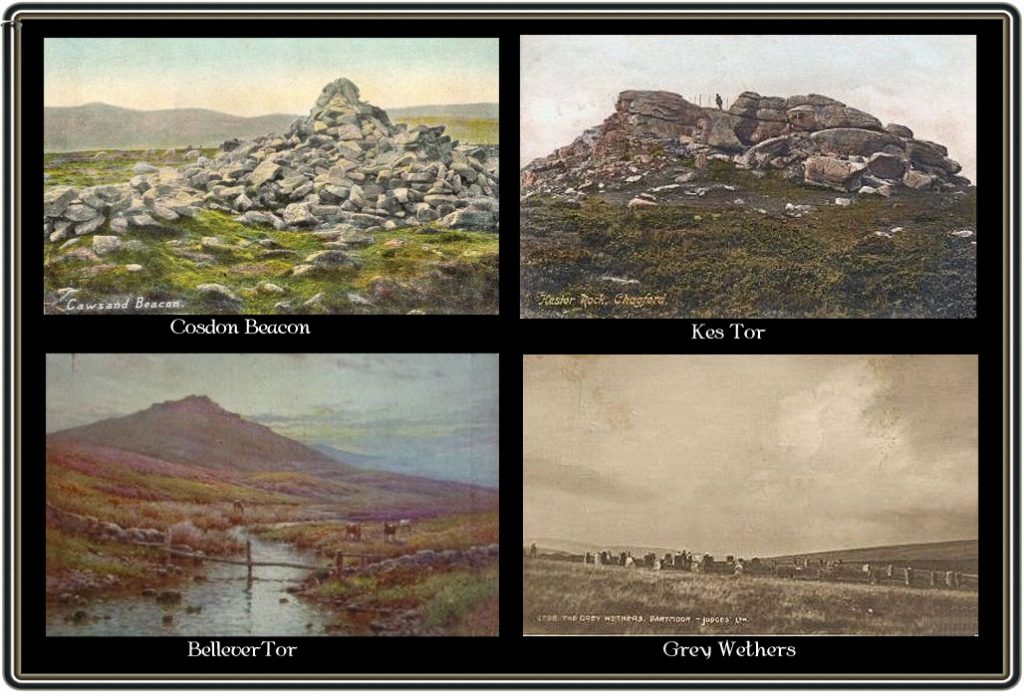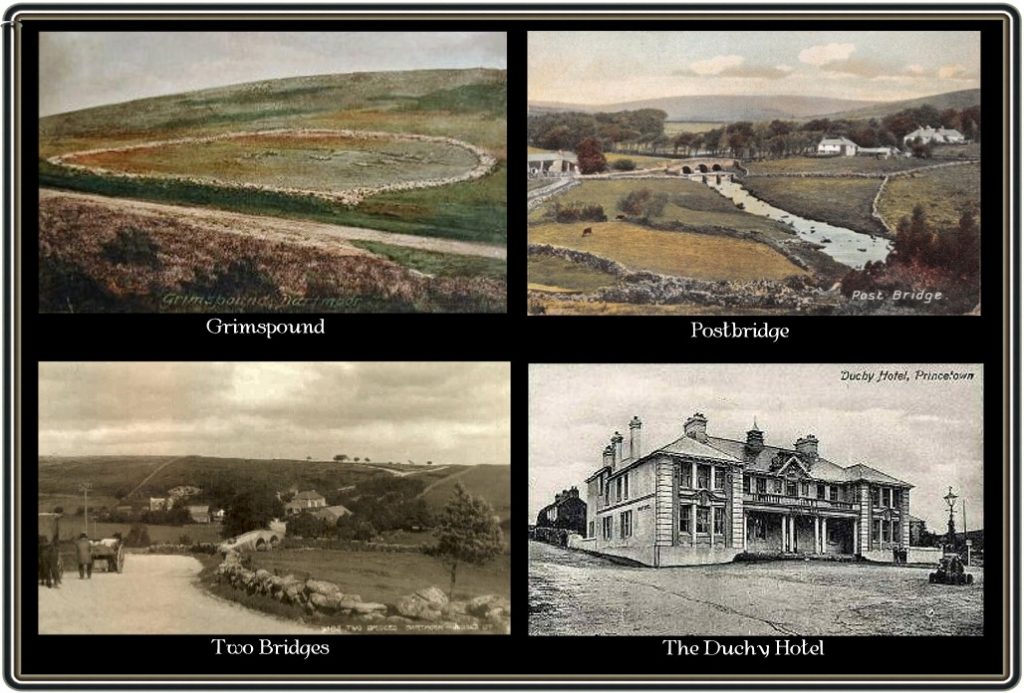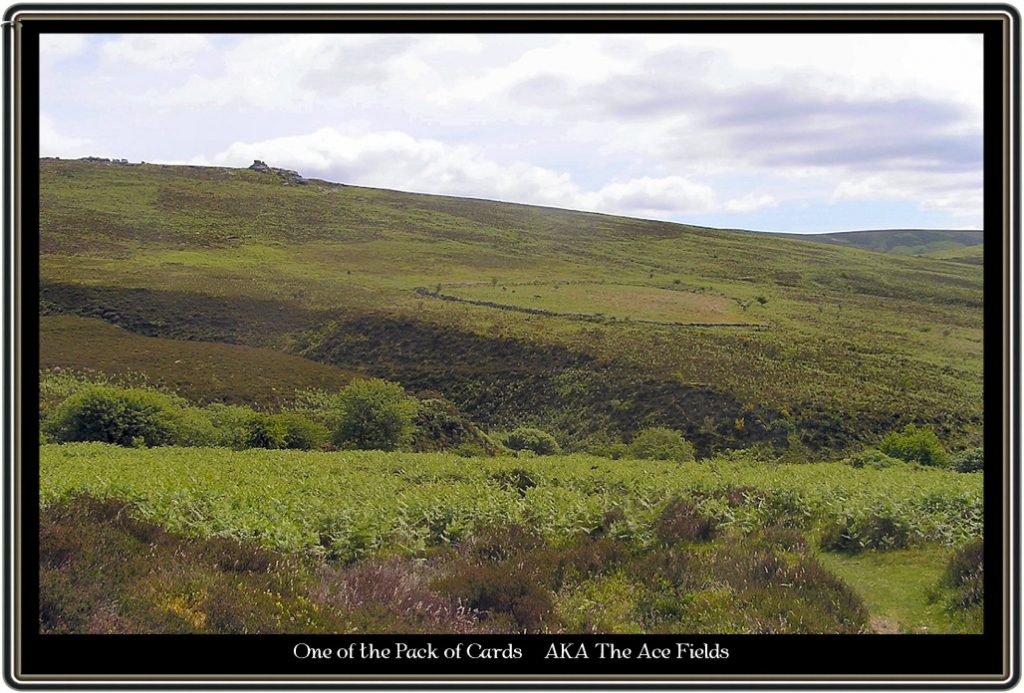
Today it’s easy to drive around the roads of Dartmoor apart from the fact that at the slowest speed of 40 miles per hour, usually with other vehicles following behind, it’s impossible to absorb the many interesting facets that the Moor has to offer. Imagine then being able to be rattle around Dartmoor driven in a four-horse break at a sedate rate which enabled every feature to be appreciated. Many old issues of local newspapers carry some very evocative accounts of such an excursion and quite often describe scenes that can no longer be seen today. The only slight drawback of such accounts is the misunderstanding of place-names, albeit down to the author’s misunderstanding of the local dialect or ‘typos’ made by the print setter. In the following account I have attempted to correct such errors where possible. So, imagine it’s a glorious June day in 1903 and you are at the White Hart in Moretonhampstead and are about to embark on one of Mr. Bright’s moorland excursions in a handsome four-horse break.
“Leaving the White Hart shortly before 11 o’clock, in a handsome four-horse break, we rattled at a rare pace through sleepy Moreton, and were soon away on the Princetown road. As the horses negotiated the first bend in the road and breasted the first hill the friendly outline of old Hay Tor loomed up on the left, and infront of us, five miles distant, Dartmoor rose threateningly in a long horizon, as if to daunt us from mounting its bosom by way of that line of road which stretched ahead and glowed in the sunlight up the hillside towards King Tor. I do not think there can be a more exhilarating experience than to pierce the heart of Dartmoor for the first time on a well-driven coach, and as we fought our way – or, to be fair, as the horses did – up that truly terrifying ascent of Worm Hill. and perceived the swelling moor, magnifying its wide proportions at our closer approach, we thought with contemptuous pity on the limitations of the upstart motorcar, speculating on the chances of one that had spluttered into these moorland hills ever spluttering out again, and voting the fastest car that ever spread destruction on the roadside a poor thing compared with our tall coach and its team of gallant steeds.
Now we passed Easdon Down on the left, and the famous Bector Cross (Beetor Cross), with Cawsand (Cosdon) Beacon and the jagged Kestor Rock, a famous hunting rendezvous, on the right. Almost immediately we entered the Moorgate, and we were verily on the Moor. It was a spirit stirring scene as we advanced. On every side and far into the distance lay ridge upon ridge, crest upon crest, of rock strewn moor, with deep misty valleys, rendered more mysterious by the fleecy clouds that rolled across a sunny sky and cast long shadows from tor to tor. A glance behind showed us the softer lines of a Devonshire country landscape in all the glory of ‘leafy June,’ and though we could no longer descry the floral beauties of the hedgerows – the multitude of snapjacks, the bluebells, the pinks, the fox gloves and the bird’s eyes – great clusters of golden gorse gleamed upon our right from the lower levels.
A turn of the head again and tors come thick upon us, so that it is almost impossible to retain without confusing the names and positions of the numerous peaks mentioned by the driver. Hound Tor, Hay Tor, and Shapley Tor are all within view, and on the right rears up the great, Grayweatner, (presumably Sittaford Tor upon which are the Grey Wethers stone circles) embracing Cawsand, Yes tor, and the loftiest tor on the moor – Wilhayes (High Willhays) – 11 feet higher than Yes Tor. Just afterwards we reach the highest point of our trip, Birch Tor, 1,425 feet high, and in an atmosphere that must be death to the consumptive fiend. Here we skirted I believe, a corner of the Lydford parish, said to be the largest in the county, in fact, there is a very good story told of a loyal couple who start every Sunday morning – mother on an old grey mare, and father on an old bay horse – at seven o’clock punctually for service at 11, and always reach the church just before the parsons enters. They live at one end of the parish and the church lies at the end of the other, but they would as soon think of attending a place of worship outside their own parish as an auld leecht inhabitant would think of going to hear an alien ‘meenster’ preach. But we must travel on. for we have gained the brow of the hill and another scenic panorama at the same time – another famous place for the meeting of hounds – Bellivor (Bellever) Tor, lying before us, and forming many misty lines of beauty into which the moorland has been curved by nature. between two hills on the left we are told exist the Vitifer and Golden Dragon (Golden Dagger) tin mines and a quaint feature of the landscape is a number of large stone enclosures called the ‘Pack of Cards’ (The Ace Fields), erected by miners, evidently when in an artistic mood, in the shape of a diamond, a heart, a club, and spade respectively. Far behind, but scarcely discernible, was the old stone circle of Grimspound, the largest and most perfect on the moor.
By this time we had arrived at the first stopping place, the Warren House Inn, with its highly impressionable signboard picture of three rabbits, presumably, and a warren, presumably, its rustic interior, its sweet smelling peat fires, its delightful old master and mistress, and its very good beer. A brief rest for the horses, a dash down one hill – with Princetown plainly visible six or seven miles away, a pull up another hill, and a descent with a proud flourish down yet another, and we passed Port Bridge (Postbridge), that wonderful little structure of the ancients, consisting of three massive slabs upon three piers of loose stones, that have spanned the Dart for ages. We were by this time approaching within measurable distance of our destination, and in rapid succession appeared Langator (Longaford Tor), Archington Tor (Arch Tor), Rocky Tor (???) close to which the stannary courts were held, and Wistman’s Wood, the last remnants of the great Dartmoor forest, which visitors will come from the other end of the kingdom to see, but which looked from the coach to have dwindled down to a mere handful of stunted trees and lowly bushes. Down another hill and around a neatly-managed but ticklish corner, and we had reached the Saracen’s Head (Two Bridges Hotel) at Two Bridges. A brief stop for refreshment, and off again, almost at once to enter upon which constitutes the prison grounds of the celebrated convict establishment at Princetown. Henceforth all was plain sailing, and we were set down at The Duchy Hotel (now the High Dartmoor Visitor Centre), Princetown, hungry as hunters, at half past one, after a most inspiriting drive across what Mr. Brook truthfully describes in his advert as the ‘Heart of the Moor’.
Mr. A. Rowe, the genial landlord of the Duchy, hospitably entertained us to an excellent luncheon, and afterwards showed us around this unique town, and told us many interesting things concerning the establishment where so many able-bodied men work for his Majesty. We were able to approach quite close as they worked in the fields or on the new wing of the prison which is being erected, and I was much struck by the leisurely manner in which seven or eight healthy-looking fellows, under the care of a couple of warders, bent themselves to the task of mending a gate by the roadside. One of them was using an awl, with a rest between each push, another held the gate – or leaned up against it – and the others appeared to be uninterested spectators. A couple of them gave me a very knowing wink – what for I don’t know – and my sympathies went out to the warders, whose duties must indeed be dull and dreary.
Princetown commands a magnificent moorland view, and from North Hessey Tor (North Hessary Tor), just above the town, St. Marychurch, Torquay, 28 miles away, can be seen on the one side, and Plymouth and the Eddystone on the other. Shortly after 4 o’ clock the return journey was commenced, and Moreton was reached before half-past six. A substantial tea, good-bye and thanks to our host – who had accompanied us on the trip – and so to home and to bed, as Pepys might have said. It may be added that this very fine trip is run with due regard to the timetables of the Great Western Railway Company. –The Devon & Exeter Gazette, June 10th, 1903.
 Legendary Dartmoor The many aspects past and present of Dartmoor
Legendary Dartmoor The many aspects past and present of Dartmoor



